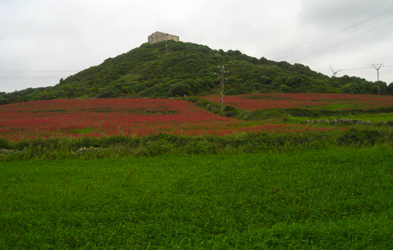Pollinator spill-over among habitats can arise in order to fulfill the pollination function and whenever differences in floral offering change over time or space. Flowering crops offer pulsed and abundant floral resources (i.e., mass flowering crops) that might promote pollinator spill-over between cultivated and adjacent natural areas. Pollinator patterns in the mass flowering legume crop Hedysarum coronarium and its influence on the bee pollinator communities of adjacent shrublands in a heterogeneous and patchy agricultural landscape are explored. The temporal and spatial functional pollinator spill-over is studied. The honeybee was highly attracted to Hedysarum crops, yet its abundance and that of other bee species visiting native plants in adjacent shrublands did not differ during and after Hedysarum mass flowering. However, at the landscape scale, the honeybee and the other bee species were less abundant in shrublands adjacent to Hedysarum crops compared to distant ones; their visitation rates showing a similar trend. These results show that some mass flowering crops can influence pollinator patterns in the surrounding landscape by competing for generalist pollinators with native plants. The characteristics of the crop species and the landscape can modulate and determine the role of mass flowering crops as competitors or supporters of wild pollinators for adjacent natural areas. informacion [at]ebd.csic.es: Montero-Castaño et al (2016) Mass flowering crops in a patchy agricultural landscape can reduce bee abundance in adjacent shrublands. Agric Ecosyst Environ 223, 22–30 doi:10.1016/j.agee.2016.02.019
http://www.sciencedirect.com/science/article/pii/S0167880916300950

 Las altas temperaturas están provocando que las lagunas y las marismas de Doñana pierdan agua rápidamente
Las altas temperaturas están provocando que las lagunas y las marismas de Doñana pierdan agua rápidamente




